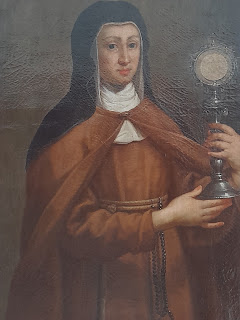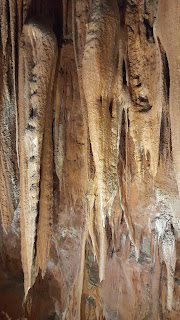Today being Sunday we decided to take a drive to Mafra and Ericeira.
First we went to Mafra to see the Convento and next to the Jardim do Cerco.
The Convento de Mafra, also known as the Palácio Nacional de Mafra, is a monumental Baroque and Neoclassical architectural complex located in Mafra, Portugal. It is one of the most important cultural and historical landmarks in the country. The complex includes a royal palace, a basilica, a monastery (or convent), and a library.
1. **Royal Palace**: The palace was commissioned by King João V in 1717 as a fulfillment of a vow to build a convent if his wife, Queen Mariana, bore him an heir. The palace was intended to serve as both a royal residence and a Franciscan monastery. It is one of the largest palaces in Europe, with over 1,200 rooms.
2. **Basilica**: The basilica at Mafra is a grand church located at the center of the complex. It is renowned for its Italianate Baroque style, featuring twin bell towers, each housing a carillon of 92 bells, which is one of the largest in the world. The interior is adorned with intricate marble work and religious art.
3. **Monastery**: The convent section housed a large community of Franciscan monks. The design of the monastery includes cells, a refectory, a kitchen, and a hospital, demonstrating the self-sufficient nature of monastic life.
4. **Library**: The Mafra library is one of the most beautiful and significant in Europe. It contains approximately 36,000 volumes, including rare manuscripts and books from the 14th to the 19th centuries. The library is known for its Rococo design, with intricate woodwork and a stunning vaulted ceiling.
The Convento de Mafra was not only a symbol of King João V’s wealth and power, but it also represented Portugal’s imperial ambitions during the 18th century. The construction was part of the broader Baroque movement in Europe, showcasing the grandeur and opulence associated with the era. The complex also reflects the religious and cultural significance of the time, blending royal authority with ecclesiastical influence.
In 2019, the Convento de Mafra was designated a UNESCO World Heritage Site, recognizing its architectural and historical importance. It remains a popular tourist destination, offering visitors a glimpse into Portugal’s rich cultural heritage.
Right next to the Convento is the Jardim da Cerca.
Jardim da Cerca is a beautiful and tranquil garden located in the town of Mafra, Portugal. It is a part of the larger Convent of Mafra complex, a UNESCO World Heritage Site renowned for its baroque architecture and historical significance. The garden itself serves as a serene green space that complements the grandeur of the convent.
The Jardim da Cerca is designed in a traditional European style, featuring carefully manicured lawns, symmetrical flower beds, and a variety of trees and shrubs. It offers a peaceful setting for visitors to relax and enjoy the natural beauty of the area. The garden also provides picturesque views of the surrounding countryside and the impressive façade of the Convent of Mafra.
One of the key attractions within the garden is its central fountain, which adds to the overall ambiance of the space. The garden is a popular spot for locals and tourists alike, offering a quiet retreat from the hustle and bustle of daily life, and it's a great place for a leisurely stroll or a quiet moment of reflection.
In addition to its aesthetic appeal, Jardim da Cerca is also a place of historical and cultural importance, reflecting the rich heritage of Mafra and its connection to the Portuguese monarchy. It’s a must-visit for anyone exploring the region and interested in both natural beauty and history.
From here we took a drive to Ericeira.
Ericeira is a picturesque fishing town located on the western coast of Portugal, about 35 kilometers northwest of Lisbon. It is part of the municipality of Mafra and has a rich history dating back to at least the 12th century. Today, Ericeira is renowned for its stunning coastal scenery, vibrant culture, and world-class surfing spots.
1. **Surfing Paradise**:
- Ericeira is often referred to as the "Surfing Capital of Europe" and is one of only a few World Surfing Reserves. The town's coastline is dotted with numerous beaches, each offering unique surf breaks that cater to surfers of all levels, from beginners to professionals.
- Some of the most famous surf spots include Ribeira d’Ilhas, Coxos, and Foz do Lizandro.
2. **Scenic Beauty**:
- The town is characterized by its stunning cliffs, sandy beaches, and the deep blue Atlantic Ocean. The old town is filled with narrow cobblestone streets, whitewashed houses with blue trim, and charming squares, providing a quintessential Portuguese coastal experience.
3. **Culinary Delights**:
- Ericeira is famous for its seafood, which is as fresh as it gets. Local restaurants offer a wide range of traditional Portuguese dishes, including grilled sardines, octopus salad, and a variety of shellfish. The town's fishing heritage plays a big role in its culinary scene.
4. **Cultural Heritage**:
- Despite its popularity among tourists and surfers, Ericeira has maintained much of its traditional charm. The town hosts several festivals throughout the year, celebrating everything from religious holidays to local traditions.
- The Nossa Senhora da Boa Viagem Festival, a celebration in honor of the town's patron saint, is particularly notable, featuring processions, music, and fireworks.
5. **Accessibility**:
- Ericeira is easily accessible from Lisbon, making it a popular day trip or weekend getaway for those staying in the capital. The town is also close to other notable Portuguese attractions, including the historic town of Mafra, known for the Mafra National Palace.
6. **Sustainable Tourism**:
- Ericeira has been proactive in promoting sustainable tourism, balancing its popularity with efforts to protect the natural environment, particularly its coastal ecosystems.
Whether you're a surfer seeking world-class waves, a traveler looking for a serene coastal retreat, or someone interested in Portuguese culture and cuisine, Ericeira offers a unique and memorable experience.







































































































